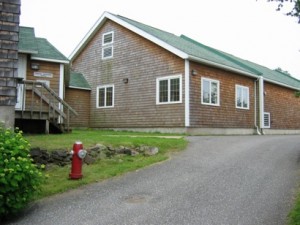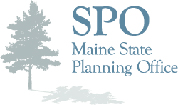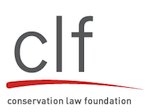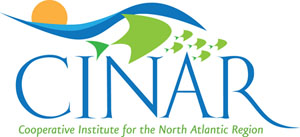You might say that the Atlantic Reference Centre, based at the Huntsman Marine Science Center in St. Andrews, New Brunswick, was a product of the laws of supply and demand.
The demand was provided by Fisheries and Oceans Canada (DFO), which each year requires thousands of samples of fish larvae to be counted and identified. The Atlantic Reference Centre was established in 1984 when Huntsman’s Icthyoplankton Lab (icthyoplankton is the scientific term for larval fish) joined with the St. Andrew’s Biological Station Identification Centre to supply state-of-the-art expertise to process DFO’s samples.
The Atlantic Reference Centre in Saint Andrews, New Brunswick
In the intervening 25 years, the Centre’s mission has expanded. It is now an authoritative source of information on a wide array of the flora and fauna of Canada’s eastern ocean environments, supports a wide variety of biodiversity related research, and provides expertise on marine issues to a range of provincial, state and federal agencies, businesses and universities.
In 2009, on the occasion of its 25th anniversary, the Atlantic Reference Centre was awarded the Gulf of Maine Council’s visionary award. These awards are made to recognize innovation, creativity, and commitment to marine protection by individuals and organizations in the Gulf watershed. The award recognized the “critical service” the Centre provides in the preservation and greater understanding of marine flora and fauna from the Gulf of Maine.
The work of the Atlantic Reference Centre is painstaking, requires sophisticated training – and must be continuously reassessed. Such is the effort that is required to support cutting-edge marine research in the Gulf of Maine and around the world.
Taxonomy, the study of the description, identification, naming and classification of organisms, is the Centre’s bread and butter. While not as glamorous as some of its research cousins, taxonomy is critical to the work of those scientists who study marine ecosystems. Ecological studies include data on the abundance and distribution of organisms – from single-celled algae to right whales. The benefits of ecological research to society depend on getting the taxonomy right. And it is not as simple as it might appear.
In the 18th century, Linnaeus, a Swedish botanist, established a hierarchical system for classifying organisms based on how closely they are related. The system starts with species, the lowest unit of classification, links closely related species together into genera, similar genera together into families and so on through orders, classes, phyla to the peaks of the animal and plant kingdoms. More levels have been added to the hierarchy but otherwise, Linnaeus’ classification is the same one we use today. However, the organization of species in the classification is continually being adjusted as more is learned about them and their relationships – and as new species are discovered.
Gerhard Pohle, Associate Director of the Huntsman Marine Science Centre and Curator of Invertebrates and Senior Applied Projects Scientist for the Atlantic Reference Centre, examining one of the Centre’s thousands of specimens.
The Centre’s expertise made it a logical partner for the Census of Marine Life, an ambitious ten-year project to understand the biodiversity of the world’s oceans. Funded by the Alfred P. Sloan Foundation and initiated in 2000, the results of the census will be presented later this year.
Lew Incze, Director of the Aquatic Systems Group at the University of Southern Maine and Chief Scientist of the Gulf of Maine Program of the Census of Marine Life, describes the importance of understanding the Gulf’s biodiversity.
“Biodiversity is the means by which the earth is equipped to deal with change. We are entering an era of unprecedented change in marine ecosystems as a result of factors like climate change and exploitation. If we fail to conserve biodiversity we are throwing away one of our inherited biological tools for coping with change. The variety of species is important because each is doing something slightly different within the Gulf of Maine ecosystem,” Incze said. “We want to understand the ecological role of each species, its function in the puzzle of the Gulf of Maine ecosystem. Ultimately, we are trying to manage and understand human activities in the Gulf. That’s how the Atlantic Reference Centre fits into the big picture.”
The Centre has a huge collection of specimens, representing some 5,000 species of algae, molluscs, crustaceans, fish and many types of marine organisms. Lou Van Guelpen, Curator of Fishes and Collections Manager for the Centre, proudly proclaims that the Centre has the “best collection of Canadian Atlantic biota anywhere.”
The specimens housed in the collection are catalogued and the information is available online to scientists sitting at their own computers anywhere in the world. This database is invaluable to researchers studying ecological processes in marine waters. To ensure consistency, the Centre uses a standard taxonomy to classify marine organisms. This standardization ensures, in turn, that researchers work from a common understanding of the description and classification of marine organisms.
As an additional resource for scientists, the Centre maintains registers of organisms from different areas along the Canadian Atlantic shore. As satellite data came online at the end of the twentieth century and information technology was developed that could process huge amounts of data, researchers embarked on large-scale studies that encompass much larger areas than previously had been studied.
“Scientists anywhere can sit at their computers,” Van Guelpen reports, “and access our registers.” The registers facilitate such research by providing consistent and standardized data on the geographic range of marine organisms. The data is available to anyone with an interest in marine biodiversity, not just scientists, and can be accessed through World Register of Marine Species and the Centre for Marine Biodiversity.
Van Guelpen described another venture that will expand the information available on the Centre’s specimens to include genetic data. “We are taking tissue samples for DNA analysis,” said Van Guelpen, “as another means of identifying species”.
The Centre’s reference collection provides back up to the registers and other databases; if questions arise about the classification of an organism, researchers can reanalyze specimens from the Centre’s collections in order to reassess its classification.
Incze, who worked closely with Centre staff to establish a register of organisms found in the Gulf of Maine, said “this register does two things. First, it is a list of all the organisms – that have been named and identified – that are on record as occurring in the Gulf of Maine. Second, and more importantly, the register tells us what is known about an organism.”
Using the dictionary as an analogy, Incze described the list of species as a reference. “If you find a species in the list you know it is a valid Gulf of Maine species just as a dictionary tells you whether a word is valid or not.” Continuing the analogy, he said, “but you also want to know how the word is used. The register provides links to information of all kinds about the species including its description, its ecological function, who identified it, etc.”
The Centre’s role in another Census of Marine Life program demonstrates the scope of the Centre’s current activities. A component of the census, known as the Natural Geography in Shore Areas project, or NaGISA, has used a standardized methodology to monitor shore areas in dozens of sites around the world. Intertidal habitats, either seaweed or eel grass habitats, are investigated at each site; the plants and animals found are counted and identified. As the Atlantic Ocean regional headquarters for NaGISA, the Centre is responsible for conducting research on NaGISA sites in Atlantic Canada and off the coast of Senegal in western Africa. Van Guelpen reports that promising results from NaGISA have inspired an effort to continue the monitoring for an additional 40 years. Projects like NaGISA allow scientists and managers to learn from the work of others in similar but distant ecosystems.
Incze reports that “the majority of organisms in the ocean anywhere in the world are unknown and unnamed.” Clearly, the role of Atlantic Reference Centre will only expand as it builds on 25 years of accomplishments and a leadership role in understanding the role of marine organisms in Atlantic Canada – and beyond.
Print




















